Related Research Articles

New Cross Gate is a railway station in New Cross, London, on the Brighton Main Line and the London Overground. It is 2 miles 70 chains down the line from London Bridge and is about 600 m (660 yd) west of New Cross station. It is in Travelcard Zone 2, and is operated by London Overground.

The London, Brighton and South Coast Railway was a railway company in the United Kingdom from 1846 to 1922. Its territory formed a rough triangle, with London at its apex, practically the whole coastline of Sussex as its base, covering a large part of Surrey. It was bounded on its western side by the London and South Western Railway (L&SWR), which provided an alternative route to Portsmouth. On its eastern side the LB&SCR was bounded by the South Eastern Railway (SER)—later one component of the South Eastern and Chatham Railway (SE&CR)—which provided an alternative route to Bexhill, St Leonards-on-Sea, and Hastings. The LB&SCR had the most direct routes from London to the south coast seaside resorts of Brighton, Eastbourne, Worthing, Littlehampton and Bognor Regis, and to the ports of Newhaven and Shoreham-by-Sea. It served the inland towns and cities of Chichester, Horsham, East Grinstead and Lewes, and jointly served Croydon, Tunbridge Wells, Dorking and Guildford. At the London end was a complicated suburban and outer-suburban network of lines emanating from London Bridge and Victoria, and shared interests in two cross-London lines.
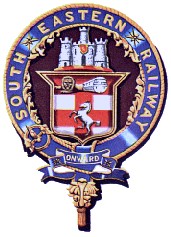
The South Eastern Railway (SER) was a railway company in south-eastern England from 1836 until 1922. The company was formed to construct a route from London to Dover. Branch lines were later opened to Tunbridge Wells, Hastings, Canterbury and other places in Kent. The SER absorbed or leased other railways, some older than itself, including the London and Greenwich Railway and the Canterbury and Whitstable Railway. Most of the company's routes were in Kent, eastern Sussex and the London suburbs, with a long cross-country route from Redhill in Surrey to Reading, Berkshire.
The London and Croydon Railway (L&CR) was an early railway in England. It opened in 1839 and in February 1846 merged with other railways to form the London, Brighton and South Coast Railway (LB&SCR).
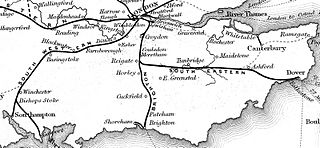
The London and Brighton Railway (L&BR) was a railway company in England which was incorporated in 1837 and survived until 1846. Its railway ran from a junction with the London and Croydon Railway (L&CR) at Norwood – which gives it access from London Bridge, just south of the River Thames in central London. It ran from Norwood to the South Coast at Brighton, together with a branch to Shoreham-by-Sea.

Forest Hill railway station serves Forest Hill in the London Borough of Lewisham, south London. The station adjoins a road which serves as part of the A205 South Circular Road.

Coulsdon North is a closed railway station that served Coulsdon, Croydon, England, on the Brighton Main Line.
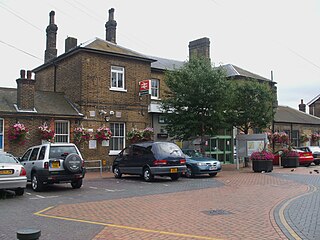
Norwood Junction railway station is a National Rail station in South Norwood in the London Borough of Croydon, south London, and is in Travelcard Zone 4. It is 8 miles 55 chains down the line from London Bridge.

Norbury railway station is a National Rail station in the Norbury area of the London Borough of Croydon in south London. It is on the Brighton Main Line, 7 miles 36 chains (12.0 km) down the line from London Victoria. The station is operated by Southern, which also provides all train services. It is in Travelcard Zone 3 and Ticket barriers are in operation at this station.
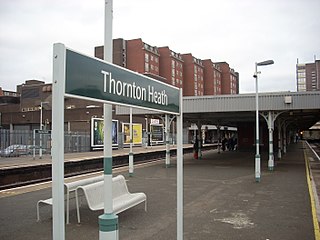
Thornton Heath is a railway station in the London Borough of Croydon in south London, 8 miles 64 chains (14.2 km) down the line from London Victoria. It is on the Brighton Main Line between Norbury and Selhurst. The station is operated by Southern, who also provide all train services.The station is in Travelcard Zone 4.
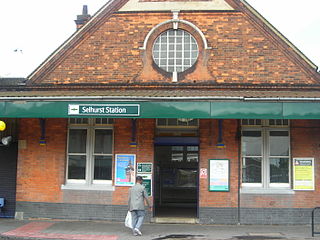
Selhurst railway station is in the London Borough of Croydon in south London, 9 miles 31 chains (15.1 km) along the line from London Victoria. It is operated by Southern, which also provides all the train services. The station is in Travelcard Zone 4.

Wandsworth Common railway station is in the London Borough of Wandsworth in south London. It is 4 miles 5 chains (6.5 km) down the line from London Victoria.

St Leonards West Marina is a disused railway station in the Bopeep area of the borough of Hastings, East Sussex. Opened by the Brighton, Lewes and Hastings Railway in 1846, it was the first permanent station to serve the area and became part of a feud between two rival railway companies over access to nearby Hastings. Although not very convenient for local services, the station became an important goods rail-head and the location of a Motive Power Depot for steam locomotives working non electrified services, including those to London. The station was closed in 1967 and the buildings subsequently demolished, although in 2023 the down platform could still be seen.
The Brighton and Chichester Railway was an early railway in southern England running between the towns of Shoreham and Chichester in Sussex. It operated between 1845 and 1846.
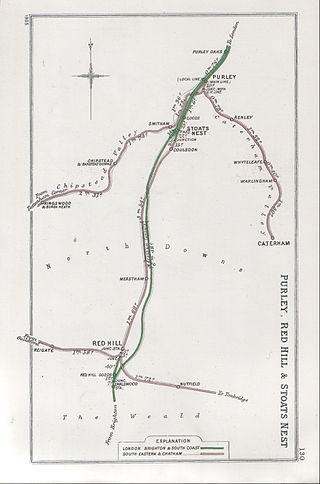
The Merstham and Quarry tunnels are two neighbouring railway tunnels on the Brighton Main Line between Merstham and Coulsdon in Surrey, Great Britain.

The Brighton, Lewes and Hastings Railway was an early railway in southern England that built the East Coastway line running between the three East Sussex towns mentioned in its name. The company existed from February 1844 but only operated trains for a few weeks during June and July 1846 before it was amalgamated with other companies to form the London Brighton and South Coast Railway (LB&SCR) on 27 July 1846.
Frederick Dale Banister MICE, was an English civil engineer, best known for his 35 years as the Chief Engineer of the London, Brighton and South Coast Railway (LB&SCR).
The Wimbledon and Dorking Railway (W&DR) was an early railway company in southern England. It was independently promoted with the intention of penetrating into West Sussex, but it only succeeded in getting authorisation as far as Epsom. It joined the Epsom and Leatherhead Railway there, and opened in 1859.
The Epsom and Leatherhead Railway (E&LR) was a railway company in Surrey, England. Promoted independently, it opened its short line in 1859 and was worked by the London and South Western Railway (LSWR). It was transferred to the joint ownership of the LSWR and the London, Brighton and South Coast Railway (LBSCR) in 1860. Those companies operated passenger trains to Waterloo and London Bridge station respectively. In 1867 the LBSCR built an extension line from Leatherhead to Dorking, with the declared intention of continuing to the Sussex coast. A new Leatherhead station was built on the new line, and the LSWR was obliged to build its own independent, new Leatherhead station; this was a terminus for some years.

Bricklayers Arms was a railway station in Southwark opened by the London and Croydon Railway and the South Eastern Railway in 1844 as an alternative to the London and Greenwich Railway's terminus at London Bridge. The station was at the end of a short branch line from the main line to London Bridge and served as a passenger terminus for a few years before being converted to a goods station and engineering facility. The goods station closed in 1981.
References
- ↑ Turner, John Howard (1977). The London Brighton and South Coast Railway 1 Origins and Formation. Batsford. ISBN 0-7134-0275-X. p.243-8.
- ↑ Turner, (1977), p.267.
- ↑ Turner, John Howard (1977). The London Brighton and South Coast Railway 2 Establishment and Growth. Batsford. ISBN 0-7134-1198-8. p.1-7.